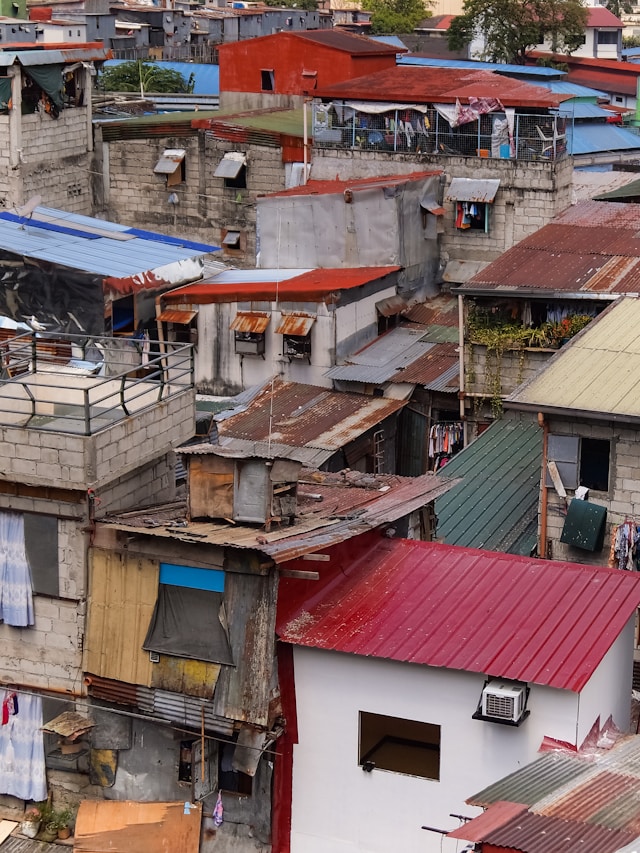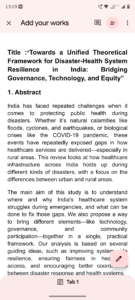By Theresa Jose
Introduction
India, saw large migrations from villages to cities by poor people seeking better job opportunities, these cities do not provide affordable housing for these groups and they are forced to settle on pavements. The main reason for the lack of housing is the lack of strict laws for the state to provide affordable housing to the poor which results in the creation of slums and the residents live every day in fear of eviction by the authorities as this could result in homelessness and deprivation of their livelihood (Thara et al., 2022). It is important to realize that these dwellers are the pillar of the city as they contribute immensely to the development of the cities (Tellis, 2015), despite the important role they play in the city, they are pushed out of the city when their labour is not necessary anymore. This paper will look into the case of Olga Tellis V Bombay Municipal Corporation, 1985 and the way the judiciary took action on the lives of the inhabitants of pavement and slum dwellings. The main issues raised due to the process of forced eviction without prior notice and rehabilitation are the violations of Articles 19(1)(e) which provides the right to reside anywhere within the country, 19(1)(g) which provides the right to practice any profession, occupation, trade or business and Article 21 which talks about the protection of life and personal liberty which shall not be deprived for any individual except according to the procedure established by the law (Olga Tellis et al. V Bombay Municipal Corporation et al.,1985). These Fundamental Rights will be analyzed through this paper in relation to the landmark Olga Tellis case (1985) to understand the rulings put forward by the court on the pavement and slum dwellers living on public lands and how the court viewed the right to life and livelihood of the slum dwellers through this case and how it impacted the future cases related to the informal settlers and the need for rehabilitation or resettlement.
Case Law and Analysis
The State of Maharashtra and the Bombay Municipal Corporation (BMC) in 1981 jointly imposed an order on the pavement dwellers to evict them by force from Bombay and drive them out to their place of origin or force them to move anywhere outskirts of the city (Olga Tellis et al. V Bombay Municipal Corporation et al.,1985). The municipal commissioner of the BMC under section 314 of the Mumbai Municipal Corporation Act, 1888 has the power to remove the encroachers without prior notice (Garg & Maheswari, 2020). So the announcement of eviction of these pavement dwellers was justified by the CM of Maharashtra giving the reason that the government did not want these dwellers to live in this inhumane condition during the monsoon even though these dwellers have been residing here for many years, but as the government failed to give them rehabilitation this justification was not expected by the pavement and slum dwellers and was met with resistance. This led to Olga Tellis, a journalist filing a Public Interest Litigation (PIL) on the issue of the forced eviction of the pavement dwellers conducted by the BMC, this is the 1985 landmark Supreme Court judgement, Olga Tellis Vs Bombay Municipal Corporation (BMC) (Olga Tellis et al. V Bombay Municipal Corporation et al.,1985; Thara et al., 2022). The petitioners were Olga Tellis and others who resided in these dwellings and the respondents were the BMC and others, who initiated the demolishing of these dwellings, this action was challenged by the petitioners as a violation of Fundamental Rights Articles 19 and 21 of the Constitution of India, a deprivation of their livelihood and right to life. Olga Tellis in a 2016 interview gave her views on the injustices faced by the slum dwellers of Bombay, she explained that “These dwellers were refugees of bad economic policies as it gave importance to the development of urban areas rather than the villages that were neglected which result in these people coming to Bombay looking for work” (Olga Tellis, 2016). As these people were not able to afford better housing facilities they settled in these pavements and slums near their workplace as it saves time and cost of commuting.
The arguments given by the petitioners were that eviction and demolition of these dwellings lead to deprivation of their livelihood as they will lose their jobs when they are forced to be evicted from the pavements and live far from their workplace which is a means to survival (Olga Tellis et al. V Bombay Municipal Corporation et al.,1985). They also argued that without protecting their right to livelihood, protection of their right to life is futile (Garg & Maheswari, 2020). The respondents argued that these pavement dwellers have no right to reside on public property and if the BMC want to evict them they can do it as the petitioners are encroaching on the public space which is a violation of the municipal laws. The respondents argued that the fundamental right article 19(1)(e) should not be used as a permit to trespass on public spaces (Naukarkar, 2021).
The BMC’s eviction process was carried out without providing prior notice or any proper rehabilitation to the pavement dwellers which deprived them of their right to livelihood which led to the endangerment of their right to life. The pavement dwellers’ rights under Article 21 were violated as they were by force evicted from their settlements where they were living for a long time without providing any kind of resettlement, this is a violation of the right to livelihood and life (Naukarkar, 2021). Also, their rights under articles 19(1)(e) and 19(1)(g) were also violated through this process of eviction by the authorities as their freedom to reside and do the job which has been their means of sustenance was taken away from them. The judgement of the Olga Tellis case led to expanding the ambit of the right to life under Article 21 by adding the right to livelihood as part of it, as the court held that evicting the dwellers without providing them with proper rehabilitation would result in depriving the pavement dwellers of their livelihoods which will threaten right to life (Naukarkar, 2021).
The Supreme Court rulings on the Olga Tellis case held that the state when executing eviction of the pavement and slum dwellers needs to protect their fundamental right to life and livelihood even though they don’t enjoy any formal legal title to the land, the SC also added that the existence of pavement dwellings and slums are due to the state’s failure to execute the constitutional duty to provide basic necessities, like housing which result in the poor people living in these places as they don’t have any other option (Bhatia, 2024). The SC recognised that the forced eviction was a violation of the right to life (Article 21 of the Indian Constitution) and it also deprived them of their livelihood which resulted in making the latter a part of the right to life. Even though the court directed that there is a need to follow a just and fair procedure when it comes to the execution of eviction as it results in deprivation of their livelihood, this right was not strictly guaranteed as if the procedure of eviction is followed fairly then they could be evicted which lead to loss of livelihood. The court also directed the provision of alternative places for dwelling but it was not made a compulsory requirement or a prerequisite for the eviction process (Thara et al., 2022). Even if the court ordered the authorities to provide alternate accommodation, it was never by considering the interests of these dwellers, as relocating areas will be outside of the city which will only lead to the poor becoming poorer without the economic opportunities they enjoyed within the city. The SC judgement ruled that if eviction leads to homelessness then it must be conducted without violation of the basic rights of the people. This shows how the Supreme Court abstained from establishing the right to rehabilitation, but the Olga Tellis judgement led to the condition that the authorities are required to figure out which residents of the pavement and slum dwellings are eligible for resettlement according to the existing policies of the centre or state before the eviction is executed (Bhatia, 2024). Although the judgement was supporting and protecting the rights of the dwellers this occurred 4 years after the eviction happened so, in reality, the pavement and slum dwellers in Bombay who were evicted were not provided with proper rehabilitation and they continued to be worse off (Idiculla, 2020).
Conclusion
Legally the BMC has the right to evict the pavement and slum dwellers if deemed necessary from the city as the latter doesn’t have any legal rights over it as it is a public property, but still, the court did not label these people as trespassers and recognized their right to live and right to protect livelihood. Through the judgement the pavement dwellers were protected from arbitrary evictions and the authorities were asked to follow a fair and just procedure. Despite the landmark judgement, the court in the long run was not able to protect the interests of the dwellers. Initially, the procedure for eviction was carried out in a just and fair manner, but the right to rehabilitation and resettlement was not upheld by the authorities. This was seen in the judgements held by the Supreme Courts and High courts over the years which was mentioned in the paper of Ramanathan (2006) where the right to housing for the dwellers who were evicted from their place of residence was not given importance and the evicted people’s issue of homelessness and deprivation of livelihood was not seen as the responsibility of the state to solve by providing them with rehabilitation or resettlement (Ramanathan, 2006; Thara et al., 2022). Thus, the essence of the Olga Tellis judgement was overlooked by the succeding judgements.
References
Bhatia, G. (2024, January 3). Right to Housing – Indian Constitutional law and philosophy. Indian Constitutional Law and Philosophy. https://indconlawphil.wordpress.com/category/article-21-and-the-right-to-life/right-to-housing/
Garg, A., & Maheshwari.S. (2020, September 11). Slum Dwellers Evicted by Court have Nowhere to Go – The Leaflet. The Leaflet – An independent platform for cutting-edge, progressive, legal, and political opinion. https://theleaflet.in/slum-dwellers-evicted-by-court-have-nowhere-to-go/
Idiculla, M. (2020). A Right to the Indian City? Legal and Political Claims over Housing and Urban Space in India. Socio-Legal Review, 16(1), 1–25
Naukarkar, P. N. (2021). Olga Tellis v Bombay Municipal Corporation Case Comment. Jus Corpus Law Journal, 2(2), 108–116.
Olga Tellis & Ors vs Bombay Municipal Corporation & Ors. Etc (1985, July 10). https://indiankanoon.org/doc/709776/?__cf_chl_rt_tk=gn7eAv9PFs3fmTVZWUbwFWtlGFWv_.whkIYY3xV7Wd0-1709138840-0.0-1575
Ramanathan, U. (2006). Illegality and the Urban Poor. Economic and Political Weekly, 41(29), 3193–3197.
Teatime interview with Olga Tellis. Pad.ma. (2016, September). https://pad.ma/IKW/player/00:01:11.116
Tellis, O. (2015, December 17). The right to home and hearth. SabrangIndia. https://sabrangindia.in/right-home-and-hearth/
Thara, K., Sangai, A., & Centre for Social and Economic Progress. (2022). Property laws and property practices in India. In Centre for Social and Economic Progress, CSEP Working Paper [Report]. Centre for Social and Economic Progress. https://csep.org/wp-content/uploads/2022/05/Property-Laws-and-Property-Practices-in-India-5.pdf






